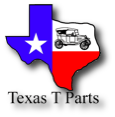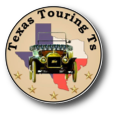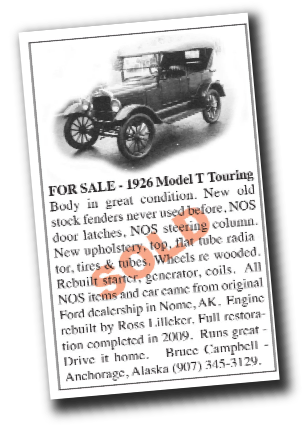
Driving it Home
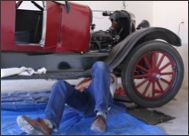
Drivetrain: When I bought the car, it had a standard drivetrain behind the engine. My preference, considering the trip we were undertaking, was to install an
auxiliary transmission to give me the climbing power that I knew we would need
to cross the various mountain ranges we would be facing. I choose the KC Warford transmission for several reasons. It would be easier to install and it would give me both an under-drive and an
overdrive. The under-drive would get me up the climbs we would face and the
overdrive would let me cruise at comfortably 40 mph on the flatlands in
non-mountainous regions. I am very pleased to have chosen and installed the Warford transmission. I shipped the Warford and a set of Rocky Mountain brakes to Anchorage and
installed them both in about 8 hours after I arrived there to pick up the car.
Chassis & Steering: The chassis and steering mechanism turned out to be well prepared for our
drive. All of the shackles and bushings had been replaced and I made sure all oilers
were in place and grease cups or fittings were in place and lubricated before
we left Anchorage. I did not lubricate the car every day but did tend to it every three or four
days. The steering shaft was not installed totally correctly and the system would
steer over center if I was not careful but after I learned what was going on, I
could work around it and it did not become a problem. That is on my list to fix soon now that I am home.
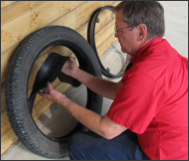
All of the wheels had been re-spoked with new wood and I never had to worry
about any of them. The left rear wheel wobbled some and several drivers along the route brought
that to my attention but I felt that it was within acceptable limits and have
not addressed that yet. I am not sure if it is the wheel, the rim, or the tire that is the issue but it
may very well be a combination of all three that can be corrected by rotating
the rim 180°.
Tires: As usual we were often asked the question; “Where do you get tires for that car?” All of the tires on the car were new Universal brand tires. They did not wear well in my opinion. The right rear tire was slick after 3,900 miles and I replaced it with the
spare. The spare that is now on the ground is about 1/2 gone. The left rear tire is now slick after 6,400 miles and will need to be replaced
immediately. I normally use Firestone tires and did not have to replace any of them on my
12,000 mile round trip to Alaska and back in 2001.
Montana Majestic Mountain T Tour
Installing a tire flap in Tok, AK.
On The Road Again
Yellowstone then Home
I had never even had a flat on either the 1987 or the 2001 trip to Alaska but
this year had a blowout flat in Denali National Park on July 8th (see the July
8th daily report). I feel the cause of the blowout was the lack of using flaps in the tires when
they were installed. It is my opinion that flaps are absolutely necessary to keep the tube from being
pinched between the tire and the rim when it flexes as the car is turning
corners or driving over rough roads. I had five tire flaps shipped overnight to Tok, Alaska, and installed them on
July 12th. I had no additional flats from any cause in the final 6,000 miles of the trip.
NOTE: Most Model T’ers will say that a 1926 car should have 21” tires. This car has 30x3-1/2” tires. The 30x3-1/2” tires were actually stock for 1926 open cars that were shipped without starters
and generators. That was news to me, also!
Body: The Touring Car body was well suited to the drive we were undertaking. We had adequate room in the back for our luggage and supplies needed for the
trip. Being on such a long trip, we had quite a lot of luggage (in my opinion, not
Nancy’s) and, being we were traveling in remote areas, I felt it was necessary to carry a good supply of spare parts. There were some things needed that we didn’t have but, other than the connecting rod, nothing stopped us from progressing
each day as planned. The connecting rod went out on the afternoon we arrived at Whitefish where we
were going to be staying in one location for a full week and where we had no
specific driving plans for the next two days. Now that is were good planning comes in - okay, good luck is helpful too. We got a replacement rod and had the car running before our touring plans
started again.
Spare Parts: The spare parts and tools you should carry on a trip like this one are really
no different than you would carry for any week long national tour. The mixture will vary slightly because, on this type of tour, you really should
plan on doing whatever it takes to keep the car running and drive it home. If you are traveling with other Model Ts, you can plan the spare parts and tools to take that do not need to be duplicated
by everyone on the tour. One part of my plan is to take a large variety of spare parts that are small and
do not take up much room. Those parts are so easy to carry and cost so little that you don’t want to leave home without them. Items such as valve springs, valve keepers and cups, woodruff keys, screws for
the Bendix spring screws for the Bendix cover, and the Bendix spring etc. fall
into this category.
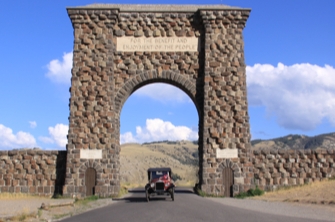
Contingency Plan: My expectation was to attempt to recover from anything short of a catastrophic
failure such as a wreck that damaged the frame or an engine failure such as
magnets coming off and destroying the hogshead and pan or a broken rod through
the side of the block. What then? Rent a car, drive home, and come back with a trailer and pick up the pieces. The important point here is to realize that, as my wife Nancy says, “With AAA and a MasterCard, you can get home from anywhere.”
The Driving:
The Roads to Choose: There is no hard rule on what roads to choose. There is certainly nothing different about picking the roads for a long tour
than picking the roads for a regular hub tour. The best roads we have found are state highways that are two lane but have wide
shoulders to drive on to let faster drivers pass. We try to avoid holding up traffic by pulling over onto a paved shoulder but we
do not sacrifice safety to do so. Watch for debris or bicyclers on the shoulders and watch for upcoming narrow
bridges that may close down the shoulder.
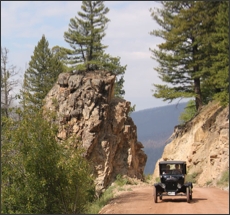
We also like to drive dirt and gravel roads because you can see so many sights
that you would never see driving a heavily travelled road. True, the unpaved roads can sometimes be rough but, when you drive a Model T,
you have no business getting in a hurry. I have encountered only one dirt road in all my trips that I did not enjoy
traveling on. It was in Monument Valley in the Navajo Nation in southern Utah/northern
Arizona. It was like driving across the desert where there was no road. It was not fun so I turned around and went back off of the road (but only after
9 miles - I’m stubborn!)
Nancy is usually hesitant to try the unpaved roads that I want to drive but
after going down them she ALWAYS has liked them and admits that it was a good
idea to try them. (She wasn’t with me in the Navajo Nation.) Our advice is try the dirt roads. You can always turn around.
We try to stay off of the interstate highways especially in big cities. One advantage of the interstates is that they always have four lanes and you won’t be blocking traffic if you drive in the outside lane. They usually have wide shoulders, too, but there is frequently a lot of debris
on the shoulder that can cause you trouble. The speed and frequency of the 18 wheelers is what makes the interstates so
uncomfortable for us so we try to avoid the interstate highways as much as
possible.

This turned out to be one of our
favorite roads on the trip.
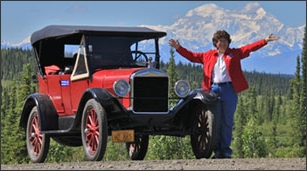
Your Durability: Don’t overlook your own durability. In additional to a durable car, a trip of this nature takes a durable driver and
a really good wife. I got lucky on both counts. However, we both started to wear down after we left the MTFCA National Tour in
Whitefish, Montana. If you are planning a lengthy trip of this nature, I would caution you to
definitely plan one layover day during each week. We did not have any layover days after the Montana tour and wished we had
planned one or two. We stayed in different locations for 13 days in a row. That means any maintenance was done before or after the day’s driving was done and we averaged almost 200 miles per day.
Your Fears: I have a saying regarding long trips in a Model T that always holds true. “The farther you are from home, the more noises you hear in your car.” Be prepared for this. Try not to overreact but be realistic about your car. Model Ts make noises. The noises change from day to day but you don’t worry about them when you are driving around close to home. When you get a thousand miles from home, you really can start hearing things
that are bothersome but are usually not anything to worry about. I’ve found that they usually go away and some other noise crops up the next day.
Enjoy your trip: The most important aspect about your Model T is the enjoyment you get out of
it. The new people you meet. The conversations you get to have. The smiles and the waves you get to return. Enjoy your trip. Expect to get tired but don’t let it wear you down. If it stops being fun, take a day off. If that doesn’t work and it’s still not fun, it’s time to quit and go home. Model T-ing is all about the fun you can have.
Nancy and I both appreciate the many comments we have received about this web
site and are glad that you have found it worthwhile to view and enjoy. We hope that you will be inspired to take your Model Ts out on the road a little
more and even use them for a vacation trip in the future. Please be careful and be safe in your travels.
May your roads be smooth and your Model T run well!
Ben Hardeman



